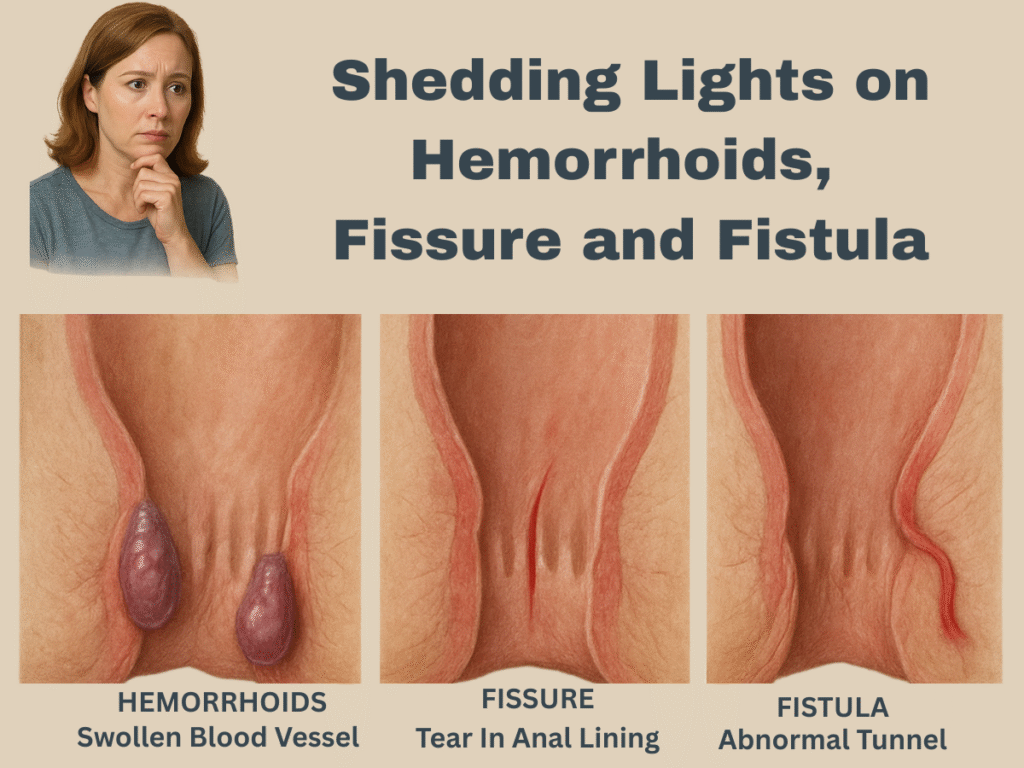
Understanding the Unspoken: Shedding Light on Hemorrhoids, Fissures & Fistulas
Hemorrhoids, fissures, and fistulas are surprisingly common yet rarely talked about due to their sensitive nature. Understanding what they are, why they happen, and how to treat them is crucial for anyone facing these challenges. This blog simplifies these conditions, offering clear, accessible information and practical guidance. Read on to gain insight, expert advice, and tips that can help you manage discomfort and improve your quality of life.
What Are Hemorrhoids, Fissures, and Fistulas?
Knowing the differences is key:
- Hemorrhoids: Swollen blood vessels in the rectum or anus, often causing discomfort, itching, and bleeding.
- Fissures: Small tears in the lining of the anal canal, typically leading to sharp pain and bleeding during bowel movements.
- Fistulas: Abnormal tunnels connecting the inside of the rectum to the skin near the anus, often resulting from infection or abscess.
Understanding these terms helps you identify symptoms early and seek the right treatment.
Common Causes & Risk Factors
These conditions can stem from different, yet sometimes overlapping, causes:
- Hemorrhoids: Straining during bowel movements, chronic constipation, pregnancy, or sitting for long periods.
- Fissures: Passing hard stools, chronic diarrhea, or trauma.
- Fistulas: Infections, abscesses, Crohn’s disease, or previous surgery.
Lifestyle factors like a low-fiber diet, dehydration, obesity, and a family history can also increase your risk. Being aware of these can help you take steps to protect your anal health.
Recognizing the Symptoms: Early Detection Matters
Prompt attention to symptoms can lead to quicker relief and fewer complications:
- Hemorrhoids: Itching, mild pain, swelling, or bright red blood on toilet paper.
- Fissures: Sharp pain during or after bowel movements, bleeding, and sometimes a visible crack in the skin.
- Fistulas: Persistent pain, irritation, or discharge near the anus, and sometimes recurrent infections.
If you experience any of these symptoms, consult a healthcare provider for an accurate diagnosis.
Treatment Options: From Home Remedies to Advanced Procedures
Treatment often starts conservatively and progresses if symptoms persist:
- Lifestyle changes: Increase fiber intake, stay hydrated, avoid prolonged sitting, and practice good hygiene.
- Home remedies: Warm sitz baths, over-the-counter ointments, and avoiding straining.
- Minimally invasive procedures: Rubber band ligation, infrared coagulation, or laser treatments offer quicker recovery and less discomfort.
- Surgery: In complex or severe cases, surgical removal or repair may be necessary.
Your healthcare provider can recommend the most suitable treatment based on the type and severity of your condition.
Prevention: Protecting Your Anal Health
Simple, daily habits can reduce your risk:
- Eat a balanced, fiber-rich diet.
- Drink plenty of water.
- Exercise regularly to promote healthy bowel movements.
- Avoid straining and prolonged sitting.
- Keep the anal area clean and dry using gentle products.
Acting early at the first sign of discomfort can also prevent minor problems from becoming serious.
Conclusion: Taking Control Through Knowledge
By learning about hemorrhoids, fissures, and fistulas, you’ve taken an important step toward better health. Prevention and awareness are your best defenses, and timely medical care ensures effective treatment when needed. Remember: staying proactive, listening to your body, and seeking expert advice empower you to live comfortably and confidently.
Stay informed, stay healthy, and keep exploring our blog for more expert insights on protecting your well-being.